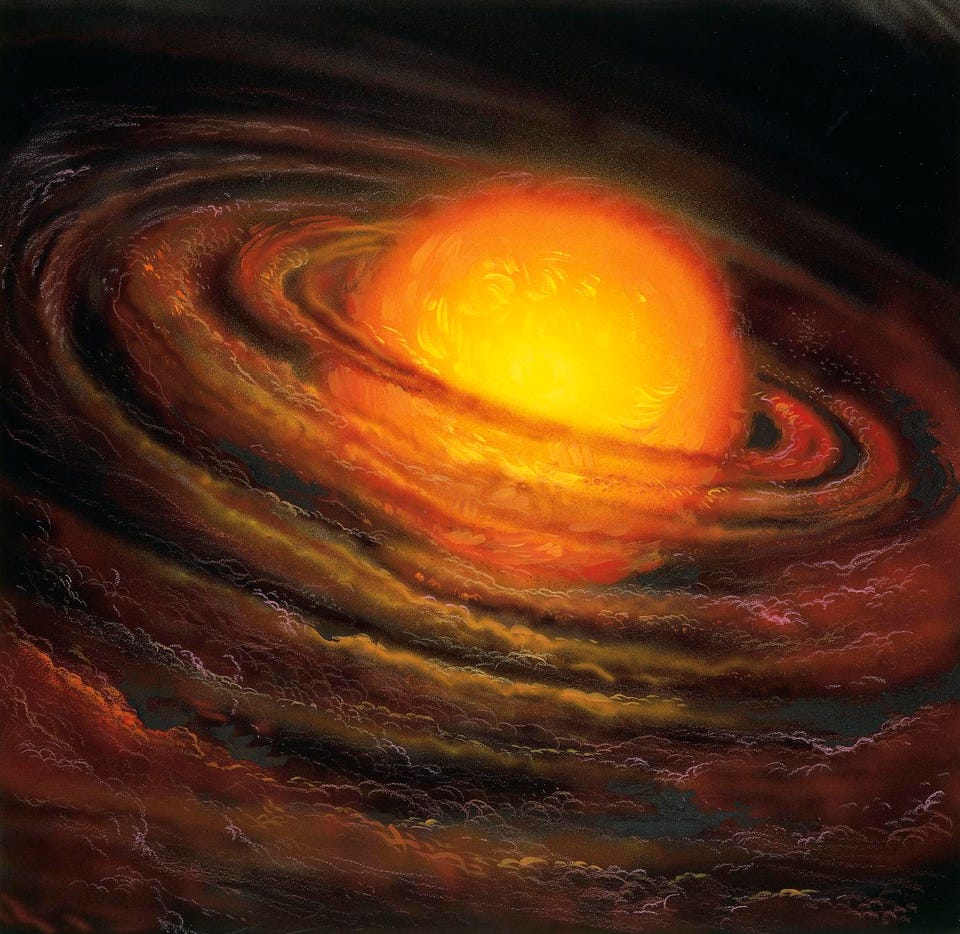Science Rare Meteorites Reveal Details Of Solar System’s Ancient Nebula Bruce Dorminey Contributor Opinions expressed by Forbes Contributors are their own. I cover aerospace, astronomy and host The Cosmic Controversy Podcast. New! Follow this author to improve your content experience.
Got it! Jul 9, 2022, 04:58am EDT | Share to Facebook Share to Twitter Share to Linkedin Primordial solar nebula, drawing. (Photo by DeAgostini/Getty Images) De Agostini via Getty Images Hard and fast details about our solar system’s beginnings are extraordinarily difficult to come by. But a research team using new measurements of pristine magnetic fields within two extremely rare meteorites have successfully modeled a portion of our solar system’s earliest evolution.
A new paper, appearing in The Journal of Geophysical Research: Planets , details new paleomagnetic measurements of samples of the Antarctic meteorites, Allan Hills A77307 and Dominion Range 08006. And for the first time, magnetic measurements within these meteorites allowed the team to constrain the lifetime and spatial evolution of our solar system’s protoplanetary disk. That is, the rotating disk of gas and dust from which our solar system’s planets first formed some 4.
56 billion years ago. Our study shows that the solar nebula —- the cloud of gas and dust out of which our solar system formed, dissipated very quickly (within less than 1. 5 million years) after having lasted for 3 million years, Benjamin Weiss, the paper’s second author and a Professor of Planetary Sciences at MIT, told me.
The mechanism that dispersed the solar nebula was heating by the young sun or winds generated by magnetic fields in the disk, he says. Researchers have long known that there was a large gap in our solar nebula around what we now call the Main Asteroid Belt. Initially, this gap was simply thought to have been caused by the formation of our gas giant planet Jupiter.
But now researchers have other ideas. MORE FOR YOU New Research Finds A Connection Between Domestic Violence And These Two Personality Disorders This Scientist Helps Andean Forests And Ecuador’s Women In STEM Exceptional Fossil Preservation Suggests That Discovering Dinosaur DNA May Not Be Impossible Isotopic data from meteorites point to two reservoirs existing in the early solar system; one of the initial hypotheses was that Jupiter created that gap, Cauê S. Borlina, the paper’s lead author and a Blaustein Postdoctoral Fellow in Earth and Planetary Sciences at Johns Hopkins University, told me.
But he says that other works provide evidence that this gap could form through other mechanisms. “The role of magnetic fields makes sense because we see evidence for it in potentially creating a gap and also driving the dissipation of the nebula,” said Borlina. On the inner side of the gap, gas and dust coalesced as terrestrial planets, including the Earth and Mars, MIT notes.
But on the icier far side of the gap, Jupiter and the outer gas giants formed, says MIT. Determining when the solar nebula dissipated sets the time for gas-driven planetary migration and for how long giant planets can grow (that is because they grow by accreting gas), says Borlina. This helped the team understand what mechanisms were responsible for the nebula’s disappearance.
What was the team’s biggest challenge? Finding the right samples to study: these two meteorites are like needles in a haystack in that they are two of the best-preserved samples from the early solar system, says Weiss. Unlike tens of thousands of meteorites, these meteorites experienced minimal heating and rusting from fluid since they formed 4. 5 billion years ago, he says.
They also had not been hit by very high pressures, and thus wouldn’t have been re-magnetized which can remove the “primary” solar nebula record, says Borlina. After we selected our samples, we can cut them into pieces of about a few millimeters and used a magnetometer to measure these samples, he says. a piece of NWA 7865: carbonaceous chondrite meteorite type 3 (CV3) Found in the Sahara desert of .
. . [+] Morocco.
Circular chondrules are visibles length = 17mm getty What’s most surprising about your results? For the first 3 million years of solar system history, our solar nebula had a very magnetic strong field (like that on the Earth’s surface today), says Weiss. Then, suddenly, in almost no time, the magnetic field, and the gas itself vanished throughout the entire inner solar system, out to some 7 Astronomical Units (Earth-Sun distances), he says. What’s next in this research? Our next step is to measure the magnetic field at the very beginning of the solar system from measurements of calcium-aluminum-rich inclusions, the oldest known solids, says Weiss.
Determining how long the nebula lasted and how quickly it went away at different locations will enable us to understand how the planets formed, he says. Follow me on Twitter or LinkedIn . Check out my website or some of my other work here .
Bruce Dorminey Editorial Standards Print Reprints & Permissions.
From: forbes
URL: https://www.forbes.com/sites/brucedorminey/2022/07/09/rare-meteorites-reveal-details-of–solar-systems-ancient-nebula/



